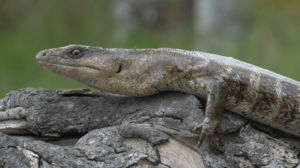Terror skink facts for kids
Quick facts for kids Terror skink |
|
|---|---|
 |
|
| Conservation status | |
| Scientific classification | |
| Genus: |
Phoboscincus
|
| Species: |
bocourti
|
 |
|
| Synonyms | |
|
|
The terror skink (Phoboscincus bocourti) is a type of lizard in the Scincidae family. It is also known by names like Bocourt's terrific skink or Bocourt's skink. This special lizard lives only on the Île des Pins (Isle of Pines). This small island is located off the coast of New Caledonia.
Scientists first described the terror skink in 1876. For a long time, people thought it was extinct, meaning it had completely disappeared. But in 1993, it was found again! Since then, more terror skinks have been seen. Because it lives in such a small area and there are not many of them, the International Union for Conservation of Nature says it is "critically endangered". This means it is at a very high risk of becoming extinct.
Contents
What's in a Name?
The terror skink's scientific name, bocourti, honors a French animal expert. His name was Marie Firmin Bocourt.
Where Do Terror Skinks Live?
The terror skink is found only on two tiny islands near the Île des Pins (Isle of Pines). These islands are off the coast of New Caledonia. The total area of these two islands is very small, about 0.9 square kilometers. That's less than one square kilometer! It's possible they might live on other nearby islands too.
This rare lizard was thought to be extinct until it was rediscovered in 1993. In 2003, experts from a French museum found one. They took pictures and videos before letting the skink go. Before that, scientists only knew about one terror skink. It was found by a man named Balanza on the same island. More skinks have been found in 2009, 2013, and 2018.
What Do Terror Skinks Eat?
The terror skink has long, sharp, curved teeth. This suggests it is a predator, meaning it hunts other animals for food. This is unusual for a large skink, as most skinks eat many different things (they are omnivorous). For a long time, no one knew exactly what terror skinks ate. People thought they might eat large invertebrates (like insects), other lizards, young birds, or eggs.
Some local stories say the terror skink got its name because it can eat fingers or other body parts. However, this is not scientifically proven.
A study in 2022 found that terror skinks mostly eat land crabs. They especially like a type of crab called Geograpsus grayi. The skink uses its big teeth and very strong bite to break through the crabs' hard shells. This makes the terror skink the only known skink that mainly eats land crabs. The study also found that terror skinks hunt another large lizard, the New Caledonian giant gecko. This means the terror skink is an apex predator, at the top of its food chain.
How Big Are Terror Skinks?
The terror skink can grow to be about 50 centimeters long, including its tail. Its body length, from its snout to the base of its tail, is about 28 centimeters. This makes it the third largest reptilian predator on its island. The other two were an extinct crocodile and a goanna (a type of lizard).
Terror Skink Behavior
Scientists believe the terror skink is active during the day (this is called diurnal). It mostly lives on the ground (this is called terrestrial). However, it might also spend some time in trees (this is called arboreal).
What Threats Do Terror Skinks Face?
Since the terror skink lives in such a small area, it faces many dangers. Things like a strong typhoon or a wildfire could destroy its habitat. Also, if new predatory animals were brought to the island, they could hunt the skinks. Because of these threats, the International Union for Conservation of Nature has listed the terror skink as "critically endangered".


